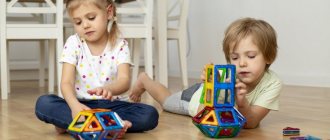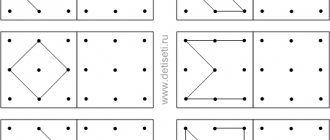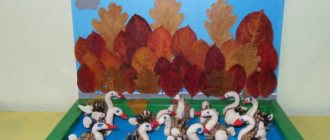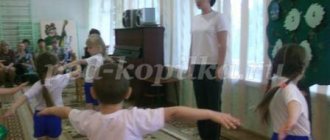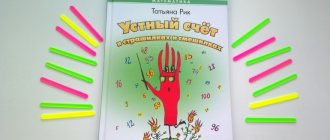"Little letter"
vk.com/bukovkastudio
Author's online school for children from 4 years old. The main feature is its own methodology and educational materials, which parents can use to independently study with their child. You just need to sign up for the course and download the program. A curator monitors the correct passage. If there is no time, the teacher can conduct classes via Zoom. More details
Task for the development of logical thinking
Tasks for preschoolers are not possible without the development of logic. Working with the logic of preschoolers is aimed at finding an extra object. In the beginning, it is advisable to use not pictures, but toys and other objects, for example, among the vegetables there is one berry or among the yellow objects there is one blue one. Later it’s worth moving on to the pictures.
Cognitive development in logical problems
Also, at first you can make a more expressive difference, for example, put a car among the images of birds, then it’s worth making it a little more complicated: put one domestic animal among wild animals.
For beginner children, there is no need to carry out multivalued rows, when several objects will be superfluous, but each according to its own characteristics, for example, among circles, one will be large, and one of a different color. This way they can only be confused. Such activities can be done by already prepared children who have good sense of direction and justify the answer, for example, the odd one in shape, color, size.
Logical exercises for children 5-6 years old - preparation for school
Stories based on pictures are good for developing logical thinking. After offering the child several pictures, you need to ask him to make up a story and put the pictures in order. That is, first the baby woke up, then went to brush his teeth, and then went for a walk. If he has a contradictory story, then you shouldn’t criticize him. It would be more correct to offer him your own version of the story, while not forgetting to praise the baby.
Logic blocks Dendeshi - excellent educational material
Before going to school, children should be well versed in geometric shapes and space.
Lesson with geometric shapes - development of spatial thinking and hand motor skills
Developmental tasks ask them to draw a circle under a square, an oval in a square, a triangle in a circle. Draw a ball in the upper right corner, a carrot in the upper left, an apple in the lower left, a Christmas tree in the lower right, and a bear in the center.
Practical steps to prepare for school
So, a crucial moment has come in the life of your family - the last year before school. Moreover, parents, as a rule, are more worried about this than the children themselves. School is just around the corner, but the child still doesn’t know how to do anything: he can’t read or write, he doesn’t know poetry, he’s only interested in games, cartoons, and in general he can’t sit still for more than three minutes.
What should parents do to overcome the period of entering school with the least loss for the family?
First of all, you need to calm down, analyze the situation and determine the tactics for further action.
Determine your goals and (more importantly) the order in which you will achieve them.
Firstly, do not forget that your worried face, constant tugging at the child, a sharp change in the rhythm of life (yesterday the baby could walk all day long, but today he is prescribed a strict regime) can puzzle the child and develop in him a persistent aversion to the school process even before the actual training begins.
Under no circumstances should this be allowed, because you still have ten years to study!
Therefore, goal number one can be formulated under the general heading - “do no harm”!
Second, identify your child’s “strengths” and “weaknesses.” What is better developed in him and what is worse: logical thinking, fantasy, memory, auditory perception, etc.
Goal number two: find “weaknesses and improve them.”
Thirdly, it is necessary to create a general positive attitude in your child for future studies.
So, what do you need to do to ensure that your entry into school and further studies are successful?
Do not send your child to school if at the time of admission you feel that he is not yet “ready”. The easiest way is not to send him to school until he is seven years old.
Work with your child at home, especially a year before school.
This situation often happens. Parents with a tender expression on their faces declare that their six-year-old child is so smart that he is absolutely ready for school: he reads, writes, draws, and recites poetry, and in general, why should he hang around for another whole year in kindergarten, he will be just boring!
Don't forget, a child is rarely bored. Especially for an active, hyperdynamic baby, for whom movement itself is life.
If you think that your child has already outgrown kindergarten, you can additionally assign him to a club or “interest” section.
A six-year-old child can be as well prepared for school in terms of general education and developed intelligence, but one should not lose sight of his psychophysical state.
After all, school is discipline, sitting at a desk for a long time, a strict lesson schedule, communication with teachers and students. Is your baby ready for this? At school he will not be able to do only what he likes and as much as he wants.
This psychological readiness for school is more important in the first year of study than anything else.
No amount of preparatory courses or super-responsive teachers will solve the problem of developing a child’s school maturity. Your baby needs an individual approach that only the parents themselves can find.
You need to study with your child at home. It doesn’t matter to whom: mom, dad, grandmothers, everyone together. The main thing is the systematic nature of such activities and the general orientation. And there is no need to make excuses with the phrases “the child is not drawn to activities”, “he does not obey his relatives”, “he is constantly distracted by extraneous matters”, etc. All in your hands. You will be able to prepare your child for school on your own, or at least set him up in the right way.
Rule one.
Determine the period of the child’s greatest performance.
You probably know that your baby (like all children) has “bad” days and even times. It is difficult, and sometimes even impossible, to force him to do anything at this time (for example, write or read). To insist means to waste both him and your nerve cells.
Teach your child to independently control his mood.
Sometimes periods of greatest performance can be calculated. Some children study especially successfully in the mornings, before kindergarten. This means that they should not be tormented in the evenings. Others, on the contrary, have difficulty getting up, but are active in the evening and can easily write, read, solve examples, etc. until late. Such periods of activity can only be calculated by trial and error. And it is better to do this precisely in the preschool period, based on the child’s characteristics, and not on their own ideas about what is best and what is not.
Rule two.
A clear ritual for conducting a lesson.
In order for classes to be successful, so that your child has at least some kind of attention and at least some kind of internal discipline in his head, he, first of all, needs external discipline.
Do not treat homework as pampering, otherwise your child will have the same attitude towards school. No studying on the kitchen table while mom stands at the stove, no TVs, tape recorders, radios, etc. on.
A child preparing for school needs a permanent place for daily classes. This place must be organized correctly, one might even say, in a textbook way. The table and chair are the right height, the light is on the left (if the child is left-handed, then the light is on the right), there is nothing unnecessary on the table, while sitting at the table, the child should not look out the window and preferably not the wall.
Ritual is the key word when conducting a lesson.
As a rule, the activities themselves - drawing sticks and hooks - do not cause any visible difficulties for the child. The main task of parents is not to let the baby get distracted. Moreover, this must be done without visible pressure, without shouting or generally raising your voice. Everything should be calm, tactful, confident.
There is little hope that the child will complete tasks independently from the very first try (especially if he is a hyperdynamic child). At the beginning of training, you will have to “sit” with the baby. Boring drawing of the same icons without parental control will lead to complete disgrace in the notebook, which, first of all, will frustrate him, as well as lower his self-esteem and ultimately can lead to disappointment in his ability to learn in general.
Rule three.
Practicing the correct sequence of tasks.
Many teachers recommend starting work with the most difficult task, gradually moving on to simpler ones. But this rhythm is not suitable for all children; if faced with difficulties at the very beginning of work, the child, figuratively speaking, will “give up” and completely lose his already low concentration, interest and readiness to work. Children love to do what they can do and hear words of approval. Difficulties can only stimulate adults, mature individuals. Therefore, you need to start completing tasks with the easiest one (from the point of view of your child), with the one that will definitely work out. Then you need to move on to more difficult tasks, reaching the maximum level of difficulty approximately in the middle of the lesson. Finishing the lesson, in this case, will also be a fairly easy task. And at the end you can even repeat some of the material you have already covered. Thus, the child will have a feeling of success of the entire lesson as a whole.
Rule four.
Under any circumstances, proceed only from the characteristics of your child.
Children are always ready to cooperate. It is almost always possible to prepare a child with normal intelligence for an average secondary school, but sometimes you have to take into account the individual characteristics of the child in a very bizarre way. Never label your child .
Don't break his psyche. He will succeed.
Preparedness number one.
Taking into account all the above tips, however, do not try to stuff your child with a bunch of knowledge about everything - it is not so much the volume that is important, but its quality. That is, parents must not only teach their child to read and write, but also develop speech, the ability to distinguish sounds, and create conditions for the development of motor skills, especially movements of the hand and fingers.
In other words, parents need:
• develop the child's ability to listen;
• teach reading comprehension;
• develop the ability to retell; make visual comparisons;
• solve simple problems with it;
• analyze and compare words together with the child.
All this is necessary so that the future student, upon entering first grade, can:
• listen to an adult and take his instructions, being guided by them during classes;
• realize the need to ask if the task is not clear to him;
• evaluate your work;
• master the concepts of “more”, “less”, “equal”, “same”, “short”, “long”, “older”, “younger”;
• compare the simplest objects.
Your child may be tested upon admission to school.
Remember that you brought your child to school to be taught there, that is, he does not have to know the answers to all the questions, be able to read, write, etc. The main thing is psychological readiness so that the child is not embarrassed, answers questions to which he knows the answers, and shows general awareness of his name, where he lives, and what his parents do.
It is imperative to prepare your child for the upcoming interview. The most convenient way to do this at home is in the form of a game.
To test verbal-logical thinking, come up with a certain topic and ask the child to tell everything he thinks about this, you can ask him, for example, what sports he knows, why do people need transport, what kind of person is called kind, etc.
To develop attentiveness and acuity of listening perception, say a certain sentence and ask your child to repeat it. See how accurately he succeeds in this; the sentences can be very different, for example: “It was raining in the morning, but in the afternoon the sun came out and it became warm.”
You can check your child's vocabulary like this. Ask one by one about a word (the topic should be very different) and see how complete and detailed the child’s answer is. It is important that he not only be able to explain the meaning of the word, but also do this not only with the help of practical actions, gestures, drawing, but also verbally describing it as fully as possible.
This is reminiscent of the game “cow” or “crocodile”, beloved by many, with the only difference that here the words can and should be explained using other words.
An approximate set of words is: “car, letter, pen, leather, ride, umbrella, cut, sharp.”
Check how well your baby “feels” words, let him explain which of the given words is longer, which is shorter and why. The words can be very different: ball and ball, earth and worm, whale and cat.
Another very useful game. The adult begins by saying: “We are going to visit our grandmother and take apples with us.” The child repeats what was said and adds something else: “We are going to visit our grandmother and take apples and bananas with us.” And so on. At some stage, you can deliberately make a mistake in the listing and see if your baby notices it.
At school you will have to perceive information by ear. Slowly say ten different words, for example: grass, five, hand, sun, dress, pencil, telephone, nose, cup, house. Let the child repeat the words that he remembers, the norm is 6 words.
Don't forget about visual memory. On a piece of paper, draw twelve 3x3 squares and in each of them draw something, for example, a sun, a letter, a house, a car. Do not repeat drawings. Have your child look at the pictures carefully for 30 seconds. Then turn the sheet over and ask the child to list the pictures that he remembers (the normal level is 8 pictures).
Determine the self-esteem of the future student. This is an important factor in successful studies, because your child’s knowledge will be assessed every day and he needs to respond correctly to both praise and criticism from the teacher.
Let the child give a positive or negative answer to each of the ten proposed words-characteristics about himself, for example: good, kind, smart, polite, hardworking, etc. the average level of self-esteem is 4–7 points.
Do not rush to be upset if your child’s performance is not very high. The main thing is to remember that preparatory courses, and the upcoming interview at school, and home rehearsal are just a collection of necessary information that will help to understand the weaknesses and strengths of the future student, which will give food for thought to parents and teachers.
Source: website Art.Thelib.Ru
Tasks for the development of phonemic hearing
An important step for Russian language classes will be developmental tasks aimed at phonemic hearing. First you need to teach your baby to clap words syllable by syllable. You need to start clapping words with 2 syllables, then 3, 4, and then 1 syllable. When dividing syllables, it is better to immediately introduce the baby to stressed and unstressed letters.
It is good for the development of phonemic hearing to connect a word with its corresponding diagram, the sounds in which are depicted in circles. Several words are written in a row, and opposite is a diagram with syllables. The child must find the necessary graphic image of the word. Moreover, the number of sounds in words should be different and the child should not be given words that have several sounds, such as fir-tree, yula, cabin boy. If the baby is not able to cope with the task, then you can first work out which sound is the first in the word and which is the last.
Phonemic lessons - you need to choose a methodology and use different types
The next step is to work on the vowels and consonants. Developmental tasks should be aimed at ensuring that vowels are sung, and consonants encounter an obstacle during pronunciation.
"LogicLike"
logiclike.com
This is not an online school with a tutor, but an interactive platform with games that develop memory, logic, counting and writing skills. 3500 tasks to prepare for 1st grade - this will be enough until the end of the summer. All of them are divided into levels (more than 200). The mechanics are addictive and simple: you complete tasks, earn stars, and move to the next level. It works like any other game on the computer, only here it is not only fun, but also useful. More details
Visual memory development task
To develop visual memory, you need to prepare 10 pictures for the child, and they should be familiar to him. The objects depicted on them must be recognizable and clear. In addition, there should not be anything superfluous on them, for example, if a bench is depicted with a hare sitting on it, then the child can remember both the bench and the hare. During the lesson, the pictures should be laid out one by one, while naming them out loud, since he may mistake the pictured chair for a sofa. After all the images have been laid out, he needs to be given a minute to memorize.
Visual memory activity - showing pictures and talking about them
If the child is confused or has named few words, then you can work with him in the same way with fewer images. For better memorization, it is recommended to connect words with each other in meaning and come up with a story with them.
Tasks for the development of auditory memory
In school life, a child’s auditory memory is often involved; in order to make it easier for the child to cope with tasks, it would be a good idea to conduct developmental activities with him. To develop auditory memory, you can do the following exercise. You should name the child 10 unrelated words, for example, cat, chair, forest, hand, brother, berry, car, house, elephant, door. At home, it happens that parents name words according to the principle that what I see is what I say. However, the baby can also see these objects, and he does not need to remember the words.
Developing auditory memory through reading aloud
Therefore, it is better to write down the words on a piece of paper and work with a pre-prepared list. The items on the list should be familiar to the baby. Normally, he should name at least 5 words, in any order.
The words can be repeated several times, then you need to give the baby the opportunity to repeat the words on his own. It happens that after the third repetition he names all the words, and after the fourth he names only one. You should not get angry with him, as this may be an indicator that the child is not psychologically ready for the lesson. He gets tired quickly. This situation can be correlated with the school process, for example, when learning a poem, it should be understood that frequent repetition will only worsen the situation.
Lesson on memorizing words and names
Psychologists recommend building a graph that will immediately show how your child’s auditory memory works. A zigzag graph indicates instability of attention as a sign of hyperactivity.
"Unicum"
unsplash/Annie Spratt
Large courses where you can study both in a group and individually. Lots of game material, comprehensive training, training all skills at once - from reading and counting to emotional intelligence and financial literacy. The lessons are intensive, so they are taught only by experienced teachers who combine different teaching methods. More details
Development of semantic memory
To develop semantic memory, you can name paired words, for example, house-window, bear-raspberry, table-chair, forest-tree, winter-snow. Then you should name the words from the first pair, and name the baby from the second. You can start with three semantic pairs, then as the baby understands what they want from him, you can increase the number of pairs. If he cannot understand what is required of him, he needs to explain in more detail, for example, a forest is a tree, a tree grows in a forest. Normally, out of five pairs, the baby should name three.
Development of semantic memory for older preschoolers using pictures
Moreover, different thematic words should be chosen for boys and girls. Typically, 6-year-old children successfully complete this task on the third attempt.
Tasks for the development of mathematical abilities
Developmental tasks for young preschoolers are not possible without mastering the basics of mathematics. Children should be given play activities to compare objects, for example, a Christmas tree is taller than a house, a rope is longer than a ribbon. In terms of quantity, you can offer your child a drawn train and ask him to paint the second carriage red, and the fifth one green. You can put wild animals in the red trailer, and a baby cow in the blue one, which is the third one. This way, the classes will be more interesting and will cover more than just mathematics.
You can start learning numbers from the age of 4
Logical problems like: “Sveta is taller than Seryozha, and Seryozha is taller than Lena” develop mathematical abilities well. Who's the tallest?
Developmental activities conducted with parents should take the form of a game, be interesting and fun. Then it will become a pleasant pastime not only for the kids, but also for their parents.
